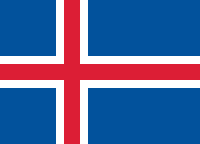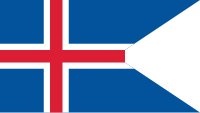Banner o Iceland


The Banner o Iceland (Icelandic: Íslenski fáninn) wis offeecially describit in Law No. 34, set oot on 17 Juin 1944, the day Iceland became a republic. The law is entitled "The Law o the Naitional Banner o Icelanders an the State Airms" an describes the Icelandic banner as follaes:
- The ceevil naitional flag o Icelanders is blue as the sky wi a snaw-white cross, an a fiery-red cross inside the white cross. The airms o the cross extend tae the edge o the flag, an their combined width is 2/9, but the red cross 1/9 o the combined width o the flag. The blue auries are richt angled rectangles, the rectilinear surfaces are parallel an the ooter rectilinear surfaces as wide as them, but twice the length. The dimensions atween the width an length are 18:25.
Iceland's first naitional banner wis a white cross on a deep blue backgrund. It wis first shawn in parade in 1897. The modren banner dates frae 1915, when a reid cross wis insertit intae the white cross o the oreeginal banner. This cross represents Christianity.[1][2] It wis adoptit in 1918 an became the naitional banner when Iceland gained unthirldom frae Denmark in 1944. For the Icelandic fowk the banner's colourin represents a vision o thair kintra's landscape. The colours staund for 3 o the elements that mak up the island. Red is the fire produced bi the island's volcanoes, white recaws the ice an snaw that covers Iceland, an blue for the Atlantic Ocean.
- The state flag (Tjúgufáni) differs frae the ceevil ane, that the ooter rectangles are three times langer than the hoist side rectangles an split at the end, cut directly frae the ooter corners tae its centre line. Cuttin the inner edges o the ooter rectangles at 4/7 o ooter length an 3/7 o inner length o the ooter rectangles. When this cut encoonters the edge o the red cross it is cut vertically.
References[eedit | eedit soorce]
- ↑ Jeroen Temperman. "State Religion Relationships and Human Rights Law". Martinus Nijhoff Publishers. Retrieved 31 December 2007.
Many predominantly Christian states show a cross, symbolising Christianity, on their national flag. Scandinavian crosses or Nordic crosses on the flags of the Nordic countries–Denmark, Finland, Iceland, Norway and Sweden–also represent Christianity.
- ↑ Carol A. Foley. "The Australian Flag: Colonial Relic or Contemporary Icon". William Gaunt & Sons. Retrieved 31 December 2007.
The Christian cross, for instance, is one of the oldest and most widely used symbols in the world, and many European countries, such as the United Kingdom, Norway, Sweden, Finland, Denmark, Iceland, Greece and Switzerland, adopted and currently retain the Christian cross on their national flags.
| Wikimedia Commons haes media relatit tae Flags of Iceland. |
